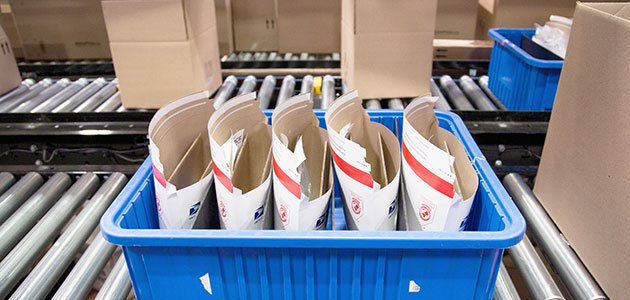
How to Select the Right Container for Conveying Products
Joe Campbell | 01 July 2015
Are you considering the purchase of a conveyor system to transport your product in the warehouse? If so, there can be many factors to consider when deciding how to convey your material, especially when it comes to the box or container holding the material. In this article, we’ll discuss a few things to keep in mind.
Container vs. Cardboard
There are several options when selecting a container for conveying products. This can make for a difficult decision as one is getting ready to transport material, so it is important to consider a few details. The first is what type of product is being conveyed. If the product can fit into a container, this may solve a lot problems with small or light products. However, you will have to bring consistently empty containers to the pack stations and do something with them once the product has been pulled from the container for shipment or putaway.
While it has been done many times, the use of reusable containers can be cumbersome and can include additional conveyor or work for employees to bring the containers to and from operators. Cardboard boxes, or the final box in which the product will be packed and shipped, is the most common way of conveying product. It is popular for two key reasons: one, you normally will not need extra conveyor to bring a separate vessel for transporting your product (as can be the case with a container), and two, there is not time spent transferring product in and out of the non-shipping container. Although boxes may be a great solution, it is also good to remember that not all boxes are conveyable, which takes us to the next consideration.
Bottom of the Container
One of the most common and critical details we consider when designing a conveyor system is how the bottom of the product or container is shaped. This plays a major role in a range of aspects: conveyor type, speed of the conveyor, and the ability to sort. We have seen all kinds of containers including a flat bottom to a variety of designs on the bottom of the box. If a plastic container is what you desire, then there a few things to look at.
First, a flat bottom or as flat as possible, is always preferred. If the bottom has any posts or protrusions, this can affect the conveyability of a product. It really comes down to the total surface area interacting with the conveyor. If there are protrusions on the bottom of the container, then those small areas are the only surface area that will come in contact with the conveyor. If this occurs, it can result in smaller roller centers, more difficult or costly sortation methods, or the switch to all belt conveyors, which can all add expense to your conveyor system. If a cardboard box is the desired method for conveying your product, then there are a few other things to look out for.
One of the biggest issues with cardboard boxes that we have seen is when a box starts to bow or inversely box. This decreases the surface area that is being conveyed and can cause major problems throughout the system. If an automatic carton erector is being used, it is crucial to make sure any extra flaps are not causing the box to be uneven on the bottom of the conveyor. If the box is bowed or has extra flaps, this can cause the box to wobble as well as cause sorting problems.
Size of the Container
It is also good to note the size of the container or box being used to ensure it can be conveyed easily. Typically, we would like to see at least a 9” long product, which allows us to convey the product on 3” roller centers and the box to be sufficiently stable. Also, most sortation solutions will require at least a 9” long product, or a more complex sortation method will have to be used.
Products have been made to solve the conveyance of small boxes, but sometimes a container must be used instead. In regards to size, the weight of the container must come in to play as well. If it is a very light product you are trying to convey, a solid container is best practice as it will give you a heavy and stable vessel. If not, the smaller product could slip on rollers or even worse, be crushed by a larger product coming in behind it.
All of these things must be considered when choosing the right type of container to convey your product. While this might be a bit intimidating, our engineers have experience with all of these scenarios. Send us your application today, and we can help determine what best fits your needs!
Joe is a District Director of Regional Solutions at Bastian Solutions. He has a Bachelor of Science in Mechanical Engineering from Indiana University - Purdue University at Indianapolis. He leads several teams of talented project and application engineers supporting many customers with automation and material handling needs throughout the MidSouthdistrict.
Comments
No comments have been posted to this Blog Post
Leave a Reply
Your email address will not be published.
Comment
Thank you for your comment.